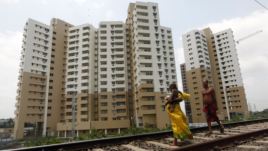Forget what you think you know about rural India. Pastoral scenes of oxen carts and bicycles are increasingly being replaced by the symbols of modern prosperity - from motorbikes and home electronics, to hair and skin care products.
Life in India's countryside still involves plenty of hard work. But standards of rural living have gone up dramatically in recent years.

Inflated food prices - otherwise a headache for politicians and urban consumers - have put more money in the pockets of farm workers. Generous government subsidies and lenient credit policies have helped fuel investment in tractors and other heavy equipment. It also has created a consumer market that makes many of India's hundreds of thousands of remote villages look a little more like cities.
"We have amenities the previous generations could never afford to have. We have motorbikes, mobile phones, a fridge, and other things," said Sanjay Singh, a rural villager.
The rural appetite for vehicles is especially strong. Shankar Prasad is one businessman cashing in on the trend.
"In the case of motorcycles we find that about 50 percent of our buyers are from rural areas and only 50 percent, rest of them are from urban areas. In case of consumer durables when there was no sale about ten years back of consumer durables. Now, we find that 50 percent of our sales are from the villages. So I will tell you the divide between the urban and rural area is blurring," said Prasad.
The investment bank Credit Suisse described that blurring of urban and rural as "the great Indian equalisation" in a recent analyst report.
Fewer and fewer rural Indians are getting their income directly from agriculture. Salim Ansari said many are finding jobs in urban-style construction.
"Just like in the city, lots of new buildings are going up here. There are car garages, towers, and big houses. We have all the city amenities in our village," said Ansari.
Wi-fi Internet is increasingly available in the countryside. So is satellite TV programming, and flatscreen monitors on which to watch it.
Stores offer convenience items many older generations never had - like instant noodles, and personal grooming products.
"In the past we used to use sticks or cow dung ash to clean our teeth," said Arun Mondal, a rural villager. "But now, just like urban people, we use a toothbrush and toothpaste. We use shampoo and expensive oils and creams. We have everything in our village that people have in towns and cities."
For mothers like Lalti Devi, the difference between the past and the present is less important than the future opportunities that rural prosperity creates for the young.
"There used to be nothing in this village. Everybody was illiterate. But now, people are sending their children to schools," said Devi.
About two-thirds of India's 1.2 billion people live in rural villages. With the overall Indian economy stagnating, policymakers can be expected to look more and more to the countryside as an engine of growth.
In rural India, medical myths spread
GM to adapt China vans for India
India plugs into low-cost solar technology
(來源:VOA 編輯:旭燕)
